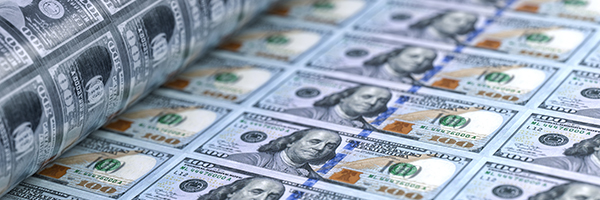 January 10, 2025
January 10, 2025
What You Need to Know Today:
Consumer confidence falls in December
The Conference Board’s gauge of costumer confidence decreased to 104.7, data released Monday showed. It was the first drop in the survey in three months. The reading of 104.7 was well below the median estimate in a Bloomberg survey of economists. More troubling to me, the survey’s measure of expectations hit a five-month low.

Please watch my YouTube video: Quick Pick Goldman Sachs
Today’s Quick Pick is Goldman Sachs (GS). This is not a cheap stock. Goldman has had a good run in 2024 and is up 55% year to date. But this is the stock to use play the financial deregulation policies of the Trump administration. We’re moving from Biden’s administration that had a relatively high degree of scrutiny in merger and acquisition deals to an administration that will come close to approving any deal Wall Street proposes. The deal pipeline is full. Companies that were waiting on the election results to move deals forward will start the process as soon as the new President is inaugurated. Running an M&A deal is incredibly lucrative for an investment bank. Goldman Sachs is a big player in this market and will benefit from doing M&As and LBOs. This pick is how I’ll be playing the Trump financial deregulation and I’ll be adding it to my Jubak Picks portfolio tomorrow.

Gold is up today on Ukraine worries, but the trend points up for all of 2025
Gold will rally to a record next year on central-bank buying and U.S. interest rate cuts, according to Goldman Sachs. The investment bank listed the metal among top commodity trades for 2025. “Go for gold,” analysts said in a note, reiterating a target of $3,000 an ounce by December 2025.

As the Cop29 climate meeting talks, the world blows through another global heating benchmark
The internationally agreed goal to keep the world’s temperature rise below 1.5C is now “deader than a doornail.” Climate scientists say that 2024 is almost certain to be the first individual year above this threshold.Three of the five leading research groups monitoring global temperatures consider 2024 on track to be at least 1.5C (2.7F) hotter than pre-industrial times. That would make 2024 the hottest year on record, beating the 2023 record. The past 10 consecutive years have already been the hottest 10 years ever recorded. This hasn’t stopped world leaders gathered in Baku from talking about how to achieve this goal.

With stocks looking stalled, Nvidia reports after the close on Wednesday
NVIDIA (NVDA) will release its third quarter results after the market closes on Wednesday. Analysts are forecasting over 80% year over year growth in both revenue and EPS. Several Wall Street firms have raised their price targets on Nvidia ahead of its earnings report, citing strong demand for AI chips and the potential for upside surprises. Analysts from HSBC, Oppenheimer, Susquehanna, Wedbush, Raymond James, and Mizuho have increased their price targets, with HSBC setting the highest at $200. The stock closed at $140.15 on Monday, November 18. On the other hand…

Saturday Night Quarterback says (on a Sunday), For the week ahead expect…
The indicator known as earnings-revision momentum— the ratio of upward versus downward revisions to analysis forecast per-share earnings over the next 12 months for the Standard & Poor’s 500 stocks—-has slumped into negative territory and is hovering near its second-worst reading in the past year, according to Bloomberg.

Special Report: 7 Steps to Protect Your Portfolio While You Still Reap Market Gains: Step #5 Bet on a very hot summer
I think that rather than trying to hedge market or sector direction in the 2024 market, I’m going to look for plays on the long side that will gain even if the market goes nowhere or tumbles, In other words, in financial jargon, I’m going to look for sectors and stocks that are uncorrelated with market direction rather than looking for sectors and stocks that are anti-correlated (where my gains depend on a downturn in the market.) That’s the logic with Step #5 today. Go long natural gas ahead of what is shaping up as a really, really hot summer.
Live Market Report (20 minute delay)

Saturday Night Quarterback says, For the week ahead don’t expect…
Don’t expect inflation worries to go away. One thing that is keeping inflation worries at full boil is the problem of understanding why inflation has stayed higher than expected for so long. Has something fundamentally changed in the economy? And could that keep inflation higher than expected for longer than now expected? The answer according to a new and disconcerting study from the Cleveland Federal Reserve Bank is “yes.” The inflationary impacts from pandemic-era supply chain shocks have largely resolved and the remaining forces that are keeping inflation elevated are “very persistent,” Cleveland Fed economist Randal Verbrugge wrote in a report released on Thursday. Inflation may not return to the U.S. central bank’s 2% target until mid-2027.

PCE inflation rose at slowest pace of 2024 in April
The Federal Reserve’s preferred measure of U.S. inflation–the core personal consumption expenditures (PCE) price index, which strips out volatile food and energy prices–rose 0.2% in April from March.That was the smallest advance in 2024, according to Bureau of Economic Analysis data out Friday. And there was more evidence of a slowing economy today.

Tomorrow’s a big day for inflation, interest rates, and the economy
Friday brings more inflation data— price indexes for April personal income and spending, including the Personal Consumption Expenditures index, the Federal Reserve’s preferred inflation measure. The PCE ran at an annual 2.7% in March and has exceeded the Fed’s 2% inflation target since March 2021.

It’s a concentrated Magnificent 7 market again
Hedge funds’ exposure to the Magnificent Seven of Nvidia (NVDA), Apple (AAPL), Amazon (AMZN), Meta Platforms (META), Alphabet (GOOG), Tesla (TSLA), and Microsoft (MSFT) has reached a record high of approximately 20.7% of their total net exposure to individual U.S. stocks, according to a report from Goldman Sachs. The proximate cause of this surge is Nvidia’s recent consensus-beating earnings report, which renewed the frenzy around artificial intelligence stocks. Nvidia has added around $470 billion in market capitalization since that report. A slightly more long-term cause is that with the consensus projection for when the Federal Reserve will start cutting interest rates moving later and later in 2024, earnings growth is increasingly the only game in town when it comes to supporting higher stock prices.

Saturday Night Quarterback say (on a Memorial Day Sunday), For the week ahead expect…
I expect Wall Street’s last rate cut bulls to get gradually less bullish. With means, expect to see interest rates (and Treasury yields) continue to rise, and the consensus on when the first cut in rates from the Federal Reserve to continue to move later in 2024. This past week economists at Goldman Sachs threw in the towel on their projections for a July interest rate cut by the Federal Reserve. The investment company moved its forecast for an initial cut to September.“Earlier this week, we noted that comments from Fed officials suggested that a July cut would likely require not just better inflation numbers but also meaningful signs of softness in the activity or labor market data,” the economists wrote in a note.Goldman Sachs had been one of the last banks on Wall Street betting the Fed would start lowering interest rates in July. JPMorgan Chase and Citigroup are among the few holdouts still forecasting a July move. Goldman is still predicting two interest rate cuts in 2024. The swaps market now fully prices in a December cut. The odds of a second reduction in 2024 stand at less than 30%, compared with about 70% last week. At the end of 2023, the first Fed cut was expected as early as March.

Nvidia beats even the most optimistic earnings forecasts
Yesterday, May 22, after the market close, Nvidia (NVDA) crushed Wall Street projections for revenue and earnings for the company’s fiscal first quarter of 2025. Nvidia reported that revenue soared 262% year-over-year to a record $26 billion, marking an 18% quarter-over-quarter increase. Adjusted earnings per share climbed 461% to $6.12. The Wall Street consensus had called for revenue of $24.65 billion and earnings per share of $5.59. And it even beat the Wall Street “whisper number,” which in a bullish momentum situation like this runs considerably above the official consensus. Data center revenue hit a record $22.6 billion, up 427% year over year. Data center revenue represents 87% of Nvidia’s total sales. For the current fiscal second quarter of 2025 Nvidia told investors to expect sales of $28 billion, up 107% year over year.

Please Watch My New YouTube Video: The Uncertainty of Uncertainty
Today’s video is The Uncertainty of Uncertainty in the Stock Market. Right now we’re seeing uncertainty on top of uncertainty. The CPI numbers just came out and April showed a slightly lower annualized inflation rate than March. The market took this as a signal that we’ve moved past inflation stagnation and have resumed the march towards 2%. This is, of course, an uncertainty. Another uncertainty is the what we don’t know about the inner thinking at the Fed. How much of a decline does the Fed really need to see to start cutting rates? Right now, according to the CME Fedwatch tool, there is a 70% chance that we’ll see interest rate cuts at the September Fed meeting. This prediction has shifted a lot in the last few months and could continue to shift. These uncertainties mean that the market may be fully priced at 5,200. Some analysts suggest we could hit 5,600 by the end of the year, making it a 15-20% year. In the short term, it’s really hard to predict how people react to all these layers of uncertainty. It’s also difficult to hedge this market so I recommend looking at individual stocks in lithium or copper that will continue to go up, even if the market as a whole doesn’t move.

Saturday Night Quarterback say, For the week ahead expect…
I’m expecting a key moment for momentum in a market that keeps setting new records on Wednesday, May 22, when Nvidia (NVDA) announces revenue and earnings for the company’s first fiscal quarter of 2025 and the quarter that ended in calendar April 2024. The consensus among Wall Street analysts is looking for the company to earn $5.17 a share. That would be a huge leap from 88 cents a share in the April 2023 quarter. The projections for revenue are every bit as optimistic.

Please Watch My New YouTube video: Hot Button Moves NOW: Buy Equal Weight S&P 500 Index ETFs
Today’s Hot Button Moves NOW video is Buy Equal Weight S&P Indexes. If you’re concerned about volatility in the tech sector but want to stay in the market, equal weight S&P indexes may be a good alternative. Stocks like Nvidia with a market cap of around 2 trillion, have a lot more weight in the common version of the market cap weighted S&P 500 index than a stock with a smaller cap. In the last week or so, we’ve seen equal weight indexes converge with the longer-term out-performance of the weighted indexes. Using an equal weight index lowers your exposure to the big, now more volatile stocks while keeping you in the market. The Invesco S&P 500 Equal Weight ETF (RSP) is a low expense ratio ETF (.2%) with about $55 billion in assets under management. Year to date, RSP is up 4.68% versus 9.9% year to date for the market cap weighted ETF from Vanguard (VOO). However, for the last 3 months you see a 4.3% return for the equal weight index versus a 4.19% for the market cap weighted index. In the last week, for the first time in a long time, the equal weight index outperformed the weighted index. While one week isn’t a trend, it does seem like the returns are converged. Shifting some S&P exposure from the large cap stocks to this equal weight ETF is a good choice to stay in the game with less volatility. I’m going to make this shift in my Perfect 5 ETF Portfolio on my subscription JubakAM.com site tomorrow May 16.

CPI inflation hits the mark for April: Is this the start of another drop in inflation, finally
Today, May 15, the April Consumer Price Index report dangled new hope in front of investors. The all-items index annual rate of inflation dropped to an annual 3.4% rate from 3.5% in March. The core index, which leaves out food and energy prices, fell to an annual rate of 3.6%, down from 3.8% in March. Those annual rates are still way above the Federal Reserve’s inflation target of 2%. But after three straight reports where the inflation rate came in above market expectations todays report, which hit projections right on the mark, came as good news. In recent weeks Wall Street has speculated that inflation is set to resume its downward course starting with the April report. And after stalling above 3.5%, annual inflation would resume its downward path.

Powell says Slow–as market waits for Wednesday CPI inflation report
Granted that the remarks weren’t delivered at the most high profile venue–a panel discussion at the Foreign Bankers Association meeting in Amsterdam–but I read Federal Reserve chairmen Jerome Powell as saying that the U.S.central bank might hold interest rates steady for longer than now expected by WallStreet. Ahead of new inflation data from the Consumer Price Index for April due tomorrow, anyway. On the day before the meeting economists were expecting the annual inflation rate at both the all-time and core levels to have dropped by 10 or 20 basis in April

Special Report: The 5 Next Big Things–The first Next Big Thing, AI Phase 2 first 6 picks
This special report is about the history of the future. And how to score big returns by investing in the future. By studying the past histories of the future, we can understand what kind of bets on the future pay off with outsized gains. Think about it this way.

Saturday Night Quarterback (on a Sunday) says, For the week ahead expect…
I expect more inflation news. What else? On Wednesday, May 15, the Bureau of Labor Statistics will release its report on Consumer Price Index (CPI) inflation for April. Even though the CPI isn’t the Federal Reserve’s preferred inflation measure (that’s the Person Consumption Expenditures (PCE) index, which won’t be released (for April) until May 31), Wall Street is looking for a trend in the CPI report that will point to the inflation rate moving lower convincingly enough so that the U.S. central bank can begin to cut interest rates at its September meeting.

Consumer confidence hits 6-month low and inflation expectations rise to 3.5% in year ahead
According to the University of Michigan survey, U.S. consumer sentiment declined in early May to a six-month low as short-term inflation expectations and concerns about the job market picked up. The sentiment index slid to 67.4 in May from 77.2, according to the preliminary reading. The figure was weaker than all forecasts in a Bloomberg survey of economists. Consumers expect prices will climb at an annual rate of 3.5% over the next year, the highest in six months and up from the 3.2% expected in April.

Please Watch My New YouTube Video: How big a danger is consumer debt?
Today’s video is How big a danger is consumer debt? The Federal Reserve has been slowly trying to get inflation down one more percentage point by slowing the economy (without crashing it). One of the things the Fed looks at is how consumers are doing. Consumer revenue is about 70% of the overall economy and consewuently the Fed has been keeping an eye on consumer debt. At the moment, debt as we can measure it, is at a high level with credit card delinquencies at 3.5% in December 2023, the highest since the current data series istarted in 2012. But that number doesn’t capture everything gong on with consumer debt since the increasingly popular Buy Now, Pay Later products aren’t included in the big consumer debt measurements. Thes products let people stretch or delay payments by cutting them into installlments. The Buy now/pay later market is currently only about $18 billion but is projected to hit $700 billion by 2029. What’s th deliquency ratw for Buy now/pay later? No one knows because the companies providing Buy Now, Pay Later programs don’t report delinquencies to credit bureaus. Anecdotally, the delinquwncy rate seems high. A Bloomberg survey found that about 43% of people in Buy Now, Pay Later programs say they’re behind or feeling pressure on their payments. 28% say they’re delinquent on other debt as a result of these payments. Th Fed faces a tough enough job of sailing the economy to a safe harbor without having to steer blind n a big and growing part of the markrt for consumer debt. My worry is that the economy may be slowing faster than the Fed would hope or can accurately measure. Keep an eye on this as the Fed continues to push rate cuts further and further down the road.

Please Watch My New YouTube Video: Quick Pick Cloud Stocks
Today’s Quick Pick is Cloud Service Infrastructure Stocks. Normally I’ll choose a specific individual stock for Quick Picks but in this case, I thought I should highlight the entire sector. It’s impossible to overstate the importance of AI technology’s effect on the economy as a whole but it’s also important to look at the individual companies and sectors that benefit from the demand this technology brings to the market. AI has created a revival of growth in the cloud service infrastructure sector, as demand for more processing on databases to run AI programming continues to increase. The sector has seen a revenue growth of about 21% year over year in the first quarter of 2024. The sector is dominated by three companies with Amazon (AMZN) holding the largest share at 31%, and Microsoft (MSFT) with 24% and Alphabet (Google) (GOOG) with 11.5%. This is a $300 billion market, and those three companies have about 66% of it. Smaller players like Alibaba (BABA) and Oracle (ORCL) have A LOT smaller shares at 4% and 3%. However, even that 3% of the market puts Oracle’s cloud revenue at $5.1 billion in the most recent quarter. Revenue in this sector is likely to continue to grow and it looks like good news for all of these companies that set the tone for the market. This is yet another way to get in on the AI boom.

This AI iPhone App isn’t from Apple
Artificial intelligence startup Anthropic is introducing its first smartphone app this week. The App will itself be free and will be to free and paid users of Claude, Anthropic’s Ai chatbot, Conversations on the app will synchronize with those conducted via the web-based version of the chatbot. The app will also be able to analyze pictures—such as from photos users take—to perform image recognition.

Finally some good news on Social Security and Medicare: They won’t be insolvent until 2035 and 2036
Social Security and Medicare will run out of money in just over a decade, a new government report warned Monday, May 6. Where’s the good news? Insolvency will come late than forecast last year thanks to the hot job market. The trustees for the massive retirement programs project that Social Security will be insolvent by 2035, and Medicare by 2036, which would force benefit cuts. Congress and the White House could act in 2025 as part of an intense debate on the extension of the Trump tax cuts of 2017, which are due to expire in 2027.

Please Watch My New YouTube video: Hot MoneyMoves NOW Tech worries
Today’s Hot Button Moves NOW video is Tech Worries. In my last video, I suggested the normal advice of “go away in May” may be valid again this year because of the revenue patterns I’m seeing in the technology sector, especially tech/consumer stocks, like Apple (AAPL). On May 2nd, Apple beat $1.50 expectations by reporting $1.53 a share. Revenue also beat at $90.8 billion (Wall Street expectations had it at $90.3 billion.) iPhone revenue was at $45.96 billion, down from $51.33 billion in 2023. The stock went up by about 6% after the report, even though it was a modest beat of already lowered expectations. Apple also announced an increase to its dividend of $.25 a share and a buyback program of $110 billion. CEO Tim Cook announced plans for the iphone to add AI in the future as Apple catches up with the use of AI at competitors such as Samsung. This promise of a wonderful future, combined with a modest beat, was enough to boost the stock. This is just one more example of a pattern I’m seeing in the sector currently where technology companies make vague, date-less promises of bigger and better things to come, with very little tangible proof or actual products. Investors are being asked to pay as if these are growth stocks, when in fact these promises may never come to fruition. The market is trying to extend a rally but “Go away in May” may be the safer bet.

Saturday Night Quarterback says (on a Sunday), For the week ahead expect…
I expect surface quiet but important movement in the lower depths of the financial markets. The week ahead lacks in obvious market-moving events and reports. There’s a smattering of earnings with Disney (DIS) on May 7 and Toyota Motor (TM) on May 8. But nothing from the likes of Apple (AAPL) or Microsoft (MSFT). A few speeches from Federal Reserve officials–Fed governors Lisa Cook on May 8 and Michelle Bowman on May 10. But no Fed meeting. No testimony from Fed chair Jerome Powell. But deep in the workings of the bond market, this will be a big week. The Treasury will auction $112 billion in Treasury paper.



